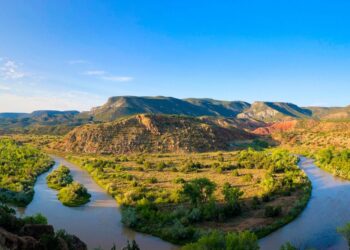National Park adventures are one of the great bucket list experiences of US travel. From epic mountain ranges to spectacular lakes, scenic waterfalls, and wildlife, discovering the great outdoors is one of our favorite pastimes. Especially on the East Coast. From the tippy top of Maine to the southernmost coast of Florida, enjoy our curated guide to the East Coast National Parks you need to explore.
Acadia National Park, Maine
Acadia National Park, southwest of Bar Harbor in Maine, was established in a series of expansions from 1916 to 1929 and covers 49,000 acres. Due to its geographical placement, it’s one of the few national parks that feature scenic coastal views as well as an epic mountainous landscape. Including Cadillac Mountain, the tallest mountain on the Atlantic Coast that gives way to domes, valleys, and beaches, making it abundant in nature and wildlife.
The Best Way to Explore it
During the warmer months (April – December), the 27-mile Park Loop Road, which includes the two-mile Ocean Drive is open and ready to be explored by car. If you’d prefer to experience it by water, take a guided boat tour or sea kayak, to take in the various lakes and ponds. Come winter and snowfall, you can cross-country ski, snowshoe, or even ice fish on the frozen ponds and lakes.
Shenandoah National Park, Virginia
Shenandoah National Park is nestled in a part of the Blue Ridge Mountains and covers 200,000 acres of land. First established in 1935, not all of the park can be explored, as almost 80,000 acres have been designated as wilderness by the National Wilderness Preservation System. The park is centered by the Shenandoah River, with the Shenandoah valley to the west and the hills of the Virginia Piedmont to the east.
The Best Way to Explore it
One of the most popular ways to explore the park is by car, along Skyline Drive, which is open 24/7. The route runs for 105 miles, north to south, along the crest of the Blue Ridge Mountains and is the only public road that exists in the park. It takes around three hours to drive end-to-end and in addition to all the spectacular nature right outside your window you’ll also be able to catch glimpses of the wildlife that call the park home, like wild turkeys, black bears, and deer.
Congaree National Park, South Carolina
Located 18 miles southeast of Columbia, South Carolina, Congaree National Park encompasses over 26,000 acres of forest land and is home to the largest tract of old-growth bottomland hardwood forest in the country. The upward view is perhaps the largest draw, where you can see the largest concentration of champion trees in the world, including a 167-foot loblolly pine and a 157-foot sweetgum. Loved by hikers, campers, and bird watchers, watching fireflies on summer nights is also part of the park’s charm. Though the grassroots campaign began in 1969, the forest didn’t become an official national park until 2003.
The Best Way to Explore it
When it comes to hiking, most visitors choose the Boardwalk Loop, which is an elevated walkway through the swampy parts of the park, spanning 2.4 miles from end to end. Beyond that, you can walk a trail as long as 11 miles on the King Snake Trail, or as short as 0.7 miles on the Bluff Trail. If hiking isn’t your thing and you prefer to explore the park by water, take a canoe or kayak along the 20-mile trail on Cedar Creek.
Great Smoky Mountains National Park, North Carolina
Though technically located in North Carolina, the Great Smoky Mountains National Park (one of the most visited in the US) is a mountain range that runs along the border between Tennessee and North Carolina. The Great Smoky Mountains are considered a subrange of the larger Appalachian Mountains. The park also serves as the passing-through point of the Appalachian Trail, which crosses through the center along its route from Georgia to Maine. The park is huge, 522,000 acres, and is one of the largest protected areas in the eastern part of the United States. One of the most popular attractions in the park is Cades Cove, a valley that is home to preserved historic churches and log cabins that can be explored by bike, foot, or car. Officially dedicated as a national park by President Franklin D. Roosevelt in 1940, it is the first national
The Best Way to Explore it
Hikers can enjoy 850 miles of trail, including 70 miles of the Appalachian Trail, which will take you to the most popular summit to climb Mount LeConte, which has an elevation of 6,593 feet. Once you reach the summit, you can camp or stay a night at the LeConte Lodge, located near the top of the peak, the only private lodge within the park.
Biscayne National Park, Florida
Biscayne National Park is located in the northern Florida Keys, just south of Miami, making it a perfect destination for ocean, nature, and wildlife lovers. The majority of the park, which covers 173,000 is water and features four distinct ecosystems: the mangrove swamp shoreline, coral limestone keys, the waters of Biscayne Bay, and offshore Florida Reef. It is also home to Elliott Key, the park’s largest island and the most northern island in the Florida Keys.
The Best Way to Explore it
Most of the park’s activities are aquatic, so you can enjoy windsurfing, kayaking, snorkeling, or scuba diving. Though a national park, fishing in Biscayne is an option, though it’s governed by the state of Florida so visitors are required to have a specific license and are limited to catching specific types of fish and shellfish. Scuba diving and snorkeling experiences are incredible in the park as there are many shipwrecks among the reefs, including an unknown ship from the 1800s, Arratoon Apcar from 1878, and Erl King from 1891.
Everglades National Park, Florida
Florida’s Everglades National Park is the largest tropical wilderness in the United States and the largest wilderness east of the Mississippi River. It is also the third-largest national park in the country, after Death Valley and Yellowstone National Park, covering a whopping 1,509,000 acres. The park is made up of a network of wetlands and forests that are all fed by a river that flows from Lake Okeechobee.
The Best Way to Explore it
Camping, hiking, and canoeing are the after adventures at Everglades. The highlight is Wilderness Waterway, a 99-mile canoe trail that takes eight days to explore from end to end. On the western coast of the park, you can discover Ten Thousand Islands which are only accessible by boat.
If you’re up for a hike, the Anhinga Trail, which is only a half mile long will take you through a marsh where you can spot alligators, turtles, and birds. Or walk the popular Gumbo Limbo Trail, which winds through tropical trees like gumbo limbo, strangler figs, and epiphytes.






